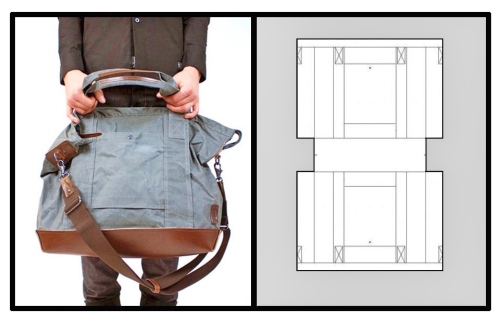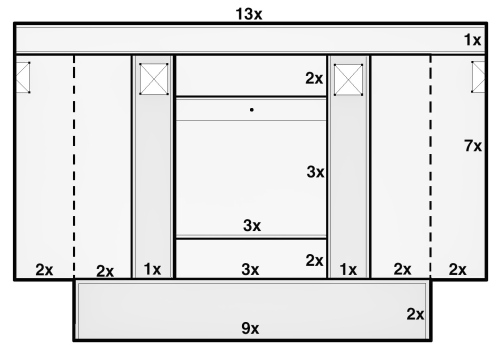
Proportionate pattern-making is another way to create cutting patterns for various fashion bag designs using their geometric shapes as the basis of the styling. While each pattern template is a different shape, they all share a common measurement or dimension, which more often than not, is its depth or gusset side length. Other times, one can use a known increment of measure from a given detail or embellishment used in the overall styling of the bag. This comes in handy to know if you only have access to limited bag supplies, as you always want to work with what is available to you. Of course this is all so abstract in approach though I like to think of it as being creative; the mathematics behind this concept is solid as a designer is utilizing proportional reasoning and spatial skills to create endless versions of favourite bag styles and shapes that share a common element that they can be put together to form interesting shapes.
This means that the areas of the shapes are proportional, a relationship that supports the illustration of various mathematical concepts. Proportionate bag pattern blocks offer a hands-on way to apply foundation grids and the Rule of Thirds, geometry, patterns, ratios, proportions, congruence, similarity, lines of symmetry, and more, in keeping with the basic principles and elements of design, that all designers use whenever they are working on a new collection, whatever may it be.
Balance is the concept of visual equilibrium, and relates to our physical sense of balance. It is a reconciliation of opposing forces in a composition that results in visual stability. Most successful bag designers achieve balance in one of two ways: symmetrically or asymmetrically. Balance in a three dimensional object is easy to understand; if balance isn’t achieved, the handbag tips over. To understand balance in a two dimensional composition, we must use our imaginations to carry this three-dimensional analogy forward to the flat surface. This is known as spatial reasoning (see post on developing spatial skills).
Symmetrical balance can be described as having equal “weight” on equal sides of a centrally-placed fulcrum or axis. It may also be referred to as formal balance. When the elements are arranged equally on either side of a centerline, such as ‘cutting-on-the-fold’, the pattern is mirrored and the result is Bilateral symmetry. This axis may be horizontal or vertical. It is also possible to build formal balance by arranging elements equally around a central focal point, resulting in radial symmetry.
There is a variant of symmetrical balance called approximate symmetry in which equivalent but not identical forms are arranged around the fulcrum line.
Asymmetrical balance, also called informal balance, is more complex and difficult to envisage. It involves placement of objects in a way that will allow objects of varying visual weight to balance one another around a fulcrum point. This can be best imagined by envisioning a literal balance scale that can represent the visual “weights” that can be imagined in a two dimensional composition. For example, it is possible to balance a heavy weight with a cluster of lighter weights on equal sides of a bag style; this might be a cluster of small compartments balanced by a large compartment on a backpack. It is also possible to imagine objects of equal weight but different mass (such as a large mass of feathers versus a small mass of jet beads on an evening clutch) on equal sides of a imaginary centerline. Unequal weights can even be balanced by shifting the fulcrum point on our imaginary scale.
Ratios and Proportions
A ratio is a comparison of two elements. Proportion refers to the relative size and scale of ratios used in a bag design and the issue being the relationship between objects or parts of a whole. This means that it is necessary to discuss proportion in terms of the context or standards used to determine proportions. Also keep in mind, the use of appropriate scale in surface design is also important. For example, an overly large textile design can overwhelm the form and appearance of a small to medium-sized handbag. A surprising aspect of proportion is the way ideal proportions can vary on the human body itself. Styles change in bags as they do in clothing.
In the example below, the pattern for this weekender travel bag is a basic rectangular shape and subsequently, sub-divided into smaller parts. In other words, it is boxy with plenty of room to pack a jet-setter’s weekend wardrobe. All bag dimensions relate to each other as all are subjected to the value chosen for ¨X¨. The scale is represented by X. Every time one changes the scale, all the bag’s dimensions change. This contributes to the congruency and similarity in design. Similar bag styles have the same shape, but may be different sizes. For figures to be congruent, the lengths of corresponding sides must have the same ratio. The shapes within the bag pattern are said to be ¨to scale¨ with each other, when all measurements are based upon X (note: there are no seam allowances added to the working pattern, so you will have to true each tracing that is made and add seam allowances).


For example if X = 2 inches, which is a good estimate of how wide the struts on this travel bag are, then the dimensions of this particular bag would be 16 inches tall (model height), 18 inches wide (model width), and 8 inches deep (model depth), with a 26-inch zipper opening. As one side of a shape grows, so do all the other sides of that shape.
In another scenario, you might have based the value of X on the width of the nylon webbing used in the bag strapping. Nylon webbing is sold in 2-inch width off of continuous rolls in a variety of fashion colours. However, your supplier is sold out and only has the 1-1/2 inch width available. By substituting 1.5 for the value of X, one can keep the relationship between the bag strapping and other bag parts, and also as a whole. In this case, the bag’s dimensions becomes 12 inches high by 13.5 inches wide by 6 inches deep. It is a smaller travel bag in size yet all parts relate with one other, in individual details and collectively as a whole. This method also works for metric measurements.
If a change in bag size does not work in your favour yet you want to retain the bag styling, choose a different component of the design to determine the value of X, such as the hardware measurements (inner diameters) or something else which is tangible within your design. Many times I will base the scale of my bag pattern on its finished depth as this particular measurement often reflects what I wish to carry in the bag cavity. In the example above, the depth amount would need to be divisible by 4, as half of a gusset equals 2X. A quarter of my desired bag depth would equal X. The choice is yours to make as you are the designer. The only time this method may not work well is if you want to replicate a favourite handbag, then you must work with the other designer’s measurements instead of your own. However you do have a finished sample in front of you, so all you need do is measure each element with a tape measure and plot out your pattern-draft.
In spatial reasoning, using such visual clues is much like using a ruler. What are the dimensions of the bag? What are the sizes of the bag details? There is no right nor wrong answer as long as all parts relate to one another. In the example given, the assumption is that the strip of material that make up the bag strut is approximately 2 inches wide. You can then visualize how many times you can ‘fit’ the strut piece into the height of the bag or the base of the bag or the exterior pocket and so forth.
Partitioned elements can now be traced off the main pattern such as the zipper facing, exterior pocket, and the handle struts. It is very accommodating. As designers, we value this harmony in our creations. It is the difference between a professionally-designed bag and a homemade one.


